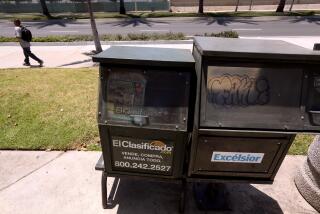Local TV Scrambles for Viewers in Face of Stiff Competition : Media: Stations across the country, pressed by cable and other rivals, are being forced to try innovative programming and other devices to keep their audiences.
- Share via
The Walt Disney Co. looks for magic when it does a deal, and its $320-million purchase a few years ago of KCAL-TV Channel 9 in Los Angeles hasn’t measured up.
Disney took a chance with the station, abandoning a broadcasting tradition of old movies and low-budget local news for an ambitious three-hour prime-time newscast. The gamble hasn’t paid off, as weak ratings and Disney’s deal last week to swap its ownership for a minority stake in a company that will own KCAL and WWOR, a New York independent station, make clear.
But Disney is hardly alone. Local TV can still be highly profitable, but it isn’t the cash cow it was a few years ago.
Stations across the country, hard-pressed by cable and other competition, have been forced to experiment with new forms of programming and try to market their products--primarily local news--in ways that would have been unthinkable not so long ago.
Even network-affiliated TV stations, once prized media assets where profit margins could top 50%, now capture less than two-thirds of the audience nationally. Independent stations, affiliates of the new Fox network, basic cable stations and pay cable services siphon off the rest.
“There used to be five channels to watch. Now there are 50,” says David Smith, a TV station consultant with Frank N. Magid Associates in Marion, Iowa. “Advertising-supported media is really being pressed. It doesn’t make the money it used to. So stations are going to have to find other sources of revenue other than their own signal.”
Until recently, the business of operating a conventional over-the-air TV station was fairly straightforward.
For an affiliate, the network supplied around-the-clock programming. A couple of hours of local news filled the gaps, along with a game show or two. Independent stations ran mostly old reruns and motion pictures--like the trademark “Million Dollar Movie”--and perhaps local sports.
But both affiliates and independents today are grappling with problems they didn’t foresee only a couple of years ago:
* The financially strapped networks have slashed the money--called “compensation”--paid to local affiliates to carry their programs by nearly 20% over the last six years. The network payments can account for as much as 10% of a station’s annual revenue.
* After the number of independents swelled to 380 nationwide, many now are spilling red ink as advertising dollars get spread thin. Especially hurt are the second- or third-ranked independents in smaller markets. But big independents are not immune; WWOR, weighted down by costly program purchases in the late 1980s, has lost money for the last two years.
Disney and its new partner, Pinelands Inc., are not saying what they may do with KCAL and WWOR. But both stations already have been experimenting with their schedules.
In Los Angeles, KCAL has taken the unusual route of producing a three-hour prime-time news block on weeknights. Ratings have gradually inched up over the last two years, although perhaps not enough to offset the steep costs involved.
In New York, WWOR broadcasts a nightly 8 p.m. talk show, “New York at Night Starring Clint Holmes”--and, like other stations with locally produced fare, hopes to cash in by selling it to channels in other cities.
Despite their perilous condition, many independents are spending money on first-run syndicated and locally produced programs to try to break out of their images as rerun ash heaps. “Star Trek: The Next Generation”--broadcast almost solely by independent stations--is one of the highest rated shows in syndication.
Still, for most stations, locally produced news is one of the few products they can call their own. Broadcasters have known for years that local news can dictate a station’s image--and hence its draw for viewers and advertising.
To that end, many stations around the country are producing news for other--competing--outlets in their own markets as a way of promoting the station and developing additional revenue.
“Tougher economics mean maximizing what you already do,” explains Randy Reiss, the Disney executive vice president responsible for KCAL.
Around the country, 48 stations are producing five-minute local news updates that are inserted into CNN Headline News on local cable TV systems. KRON Channel 4 in San Francisco, for example, is producing two different versions--for the city of San Francisco and the East Bay--reaching a total of 400,000 subscribers.
In San Diego, CBS affiliate KFMB Channel 8 is producing a half-hour news program that appears on the local Cox cable TV franchise at 10 p.m.--an hour before KFMB’s own late news. And KIRO Channel 7 in Seattle is also producing a 10 p.m. newscast for UHF independent KTZZ Channel 22.
“It’s extremely difficult to do,” concedes Jim Holtzman, KFMB’s news director “There has not been a stampede of viewers so far. People are discovering it one by one. But it’s a service that’s good for our image, and there’s money to be made.”
Like KFMB, most of the TV stations trying to increase their “shelf space” on the TV dial are finding viewers hard to lure.
Last year, NBC-owned WRC Channel 4 in Washington began a highly publicized effort producing a live half-hour newscast for rival WFTY Channel 50. But the broadcast was canceled after a few months because less than 1% of viewers tuned in.
Still other broadcasters are trying to fight cable by joining it. Tribune Broadcasting and Hearst Broadcasting, which both own major station groups, are developing regional all-news cable stations in Chicago and New England, respectively.
Slicing Up the Pie The onslaught of competition from cable television-both basic channels and such pay services as Showtime and HBO-has eaten into viewership of traditional over-the-air-stations. Localindependent channels have been among the hardest hit. Share of viewership, weekly average, March, 1992 Basic cable channels: 24% Pay TV channels: 5% Public TV stations: 3% Independent stations: 11% Total is over 100% because of multiple-set households Source: A.C. Nielsen Co.
More to Read
The biggest entertainment stories
Get our big stories about Hollywood, film, television, music, arts, culture and more right in your inbox as soon as they publish.
You may occasionally receive promotional content from the Los Angeles Times.










